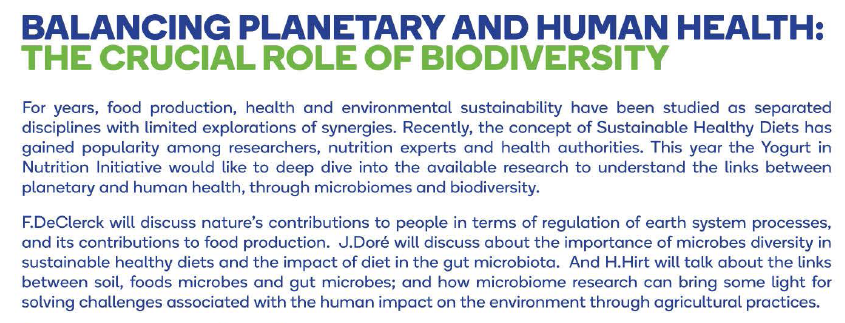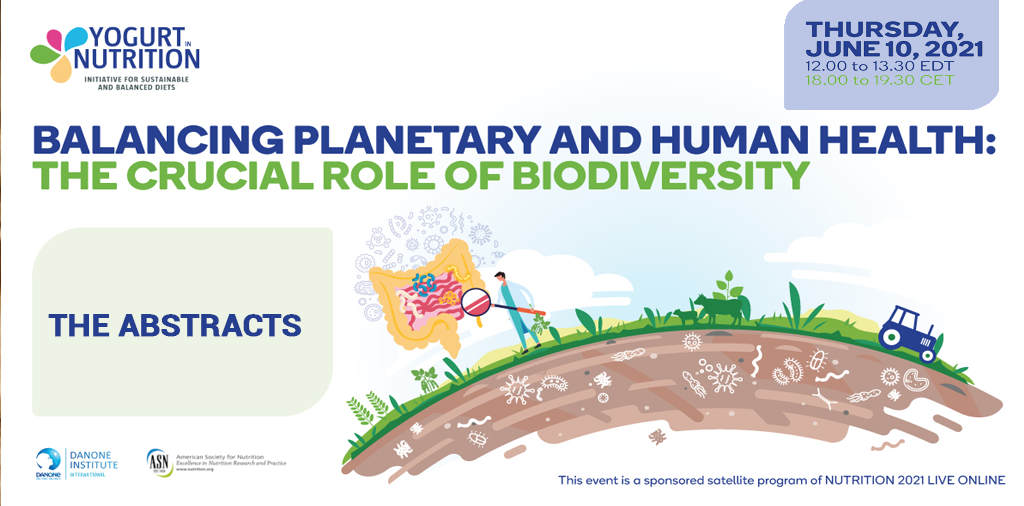On June 10th, 2021, the new online symposium will be organized, as sponsored satellite program of Nutrition Live Online 2021, on the topic of “Balancing planetary and human health: the crucial role of biodiversity“, with the interventions of Fabrice DeClerck, Joël Doré and Heribert Hirt.
Discover and download below the book of abstracts of the symposium.

One earth : Increasing evidence of the interconnection between planet, people & health by Fabrice DeClerck
If covid has taught us anything, its that we live in a biological world. Four billion years of evolutionary history precede our presence, and have driving the biological processes, interactions human life livable: from the air we breathe, the stable climates we enjoy, the clean water that courses through many landscapes, and more fundamentally, to the foods we eat.
Food production is our most intimate relationship with nature, yes all to often, in our quest to produce more food, we have driven nature out. Food is also our most intimate relationship with health: what food we eat, how we produce them, where we produce them. Yet this these relationships are now broken. Food has become the primary driver of poor health, and the leading cause of premature mortality globally. Nearly half of the world’s population struggle with either gaining access to the enough food, or the right foods. Over consumption has become both a health problem, and an environmental problem. Food is also the single largest source of environmental degradation driving planetary boundaries to critical tipping points. We are beginning to understand the consequences of foods transgression of climate, land, water, and nutrient boundaries, both in the increasing instability of climate, but also the increased risks of zoonotic disease infection and spread.
Despite this, food is our best bet solution at improving livelihoods, regenerating and restoring the environment, and preventing pandemics. Making this transition requires however fulling embedding food into nature, a one earth approach where land is spared from conversion to support nature’s contributions to people, but also here nature is shared in food, whether its habitat for pollinators around farm fields; whether its regenerative pasture management to store carbon, protect grassland biodiversity, and create jobs; whether it means recognizes the microbiomes in our soils, and in our guts are active participants in soil and human health.
A one earth approach fundamentally recognizes the biological nature of life on earth, and seeks to create the innovations, the industry, the technologies and practices that work with nature, rather than against it, and proposes by doing so, we will be able to achieve sustainability targets, and build back better.
Gut microbiome diversity: the link between food, gut microbiota and health by Joël Doré
The human intestinal tract harbours a complex microbial ecosystem which plays a key role in nutrition and health. Interactions between food constituents, microbes and the host organism derive from a long co-evolution that resulted in a mutualistic association. Recognized functions of the dominant gut microbiota relate to a contribution to nutrition via provision of key vitamins such as B12 and K and short fatty acids as well as major implication in the breakdown of fibers and the bioconversion of plant-born polyphenols. It also contributes to trophic functions of the gut, modulation of tissue renewal and mucus production in quantity and composition. Finally, it regulates the vigilance of the immune system and directly prevents proliferation of environmental microbes.
Current investigations into the human faecal microbiome are refining our vision and highlighting its most redundant genomic traits and thereby its functional contributions. These observations show a unique segregation of the human population into individuals with low versus high gene-counts or microbiota richness. It significantly expands our ability to look for dysfunctions and specifities of the prognostic and diagnostic value in immune mediated conditions. As an example, the microbiota is a key player in the development of obesity. The overall phenotypic characteristics are worse in obese people with low gene counts (LGC) microbiota, which represent 25% of the overweight to moderately obese subjects and up to 75% of extreme obese (candidates for bypass surgery). LGC patients present a low grade inflammatory context also associated with insulin-resistance, and the worst response to a dietary intervention in terms of weight loss or improvment of biological and inflammatory characteristics. Conversely, a calorie-restricted diet, with low fat, high protein and especially high-diverse fiber content, can correct the low gene count microbiota, raising by more than 25% its gene count during a 6 weeks intervention. Gastric bypass surgery rapidly corrects average gene richness and restores higher proportions of symbiont that appears deprived in extreme obesity. The effect seem durable over a 12 months follow-up.
The human intestinal microbiota should hence be regarded as a true organ, amenable to rationally designed modulation for human health. Dysbiosis and dysfunctions appear in essence as alterations of man-microbes symbiosis which trigger interest in the application of functional metagenomics to better understand the crosstalk between intestinal symbionts and food constituents on the one hand, and human cells and tissues on the other hand.
The importance of microbiome diversity: Link between soil microbiome, plant, food and health by Heribert Hirt
Recent findings show that beneficial microbes are essential for establishing and maintaining a healthy gut microbiome. Many of these beneficial microbes in the human gut can be obtained from eating healthy food, but most current healthy food concepts still lack the aspect of healthy microbes. It is hardly known that many of these beneficial microbes in healthy food are also essential for protecting plants from bacterial, fungal and viral diseases and that the large use of pesticides and herbicides in agriculture challenges the life of gut, plant and soil microbes – and that it is the soil microbiome which is the ultimate source of microbial partners for plants, animals and humans alike.
In our research program, we have isolated more than 3000 beneficial microbes that live in symbiotic association with plants. By using sophisticated techniques and bioinformatic programs, we identify specific functions of different microbial strains with respect to plant and/or human health. We show that beneficial microbes can protect crops from environmental stress and diseases. Our research provides novel strategies for developing sustainable agriculture that allows the production of healthy food on a global scale. We believe that healthy food forms the basis of human health and that we must aim to make healthy food available to every human on this planet.



